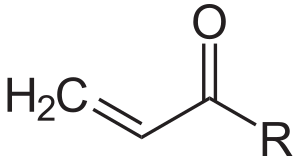Acryl facts for kids
Acryl is a name for a group of chemical compounds. These compounds contain a special part called an acrylic group. Acryl also refers to polymers, which are large chains made from these compounds.
You might know acrylic best from things like paints, dyes, or adhesives (glues). Many of these products use substances called esters, which are made from acrylic acid.
What is the Acryloyl Group?
In the world of organic chemistry, the acryloyl group is a specific part of a molecule. Think of it as a special building block. Its chemical formula is H2C=CH–C(=O)–. This group comes from acrylic acid.
Scientists often call this group prop-2-enoyl. Sometimes, people also call it acrylyl or just acryl. Any compound that has an acryloyl group is known as an "acrylic compound."
How Acrylic Compounds Work
Acrylic compounds are special because they have two important chemical bonds close together:
- A carbon-carbon double bond (C=C).
- A carbon-oxygen double bond (C=O).
These two double bonds are connected by a single carbon-carbon bond. This arrangement gives acrylic compounds some interesting features:
- The C=C bond can easily join with other chemicals, like acids or halogens. This process is called electrophilic addition.
- The C=O bond can also react in different ways, for example, in esters or ketones.
For example, the part of acrylic acid called the carboxyl group can react with ammonia to make a substance called acrylamide. It can also react with an alcohol to form an acrylate ester. These reactions are how many acrylic products are made.
See also
 In Spanish: Acrílico para Niños para niños
In Spanish: Acrílico para Niños para niños


